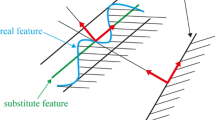Abstract
In current research of computer aided tolerancing (CAT), how to build models with tolerance and how to generate 3D dimension chains automatically have been tough problems and still unsolved. This paper builds a simulated toleranced CAD geometrical model (STCAD model) based on the feature-based original idealized CAD geometrical model (OICAD model), which can simulate real parts with manufacturing dimension errors from different aspects. Further more, an automatic generation method of 3D dimension chains based on some newly proposed definitions is put forward. In this method, firstly the conception of part instantiation (PI) is realized, secondly performance feature is defined, thirdly through building STCAD models, drive dimensions can be obtained which are vectorized to build drive dimension skeleton model (DDSM), and finally 3D dimension chains can be obtained by DDSM and the method of space projection. This method can generate 1D, 2D, and 3D dimension chains of parts or assemblies. It is verified in our own-developed automatic generation system of 3D dimension chains .
Similar content being viewed by others
References
Zhaotong W, Jiangxin Y (1999) Computer aided tolerance optimization design. Zhejiang University Press, Hang Zhong, Zhejiang, China
Zone-Ching L, Dar-Yuan C (2002) Cost-tolerance analysis model based on a neural networks method. Int J Prod Res 6:1429–1452
Chen M-C (2001) Tolerance synthesis by neural learning and nonlinear programming. Int J Prod Econ 70:55–65
Nigam SD, Turner JU (1995) Review of statistical approaches to tolerance analysis. CAD 1:6–15
Ji S, Li X, Ma Y, Cai H (2000) Optimal tolerance allocation based on fuzzy comprehensive evaluation and genetic algorithm. Int J Adva Manuf Technol 16:461–468
Yang CC, Achutha Naikan VN (2003) Optimum tolerance design for complex assemblies using hierarchical interval constraint networks. Comput Ind Eng 45:511–543
Lizhong T, Yulin M, Shuping J (2000) Research on generating assembly dimension chain automatically. Eng Des 4:21–24
Yongtao H, Jinan G, Juan H (2003) Research on the generation of dimension chain at Pro/engineer platform. Manuf Inf Eng China 7:127–129
Yang W, Chunhe W, Feng G (1998) Research on feature-based assembly tolerance chain generating and analyzing automatically. J CAD CG 2:138–144
Kewu W (2000) An algorithm of finding and calculating dimension chains. J Lianyungang Technical College 3:35–37
Di X, ZGenbao Z, Xuchu W (2001) A method of tolerance modeling and its application on automatic generation of dimension chains. Mach Tool Hydraulics 6:156–157
Sigmetrix (2002) CETOL 6σuser reference manual version 6.0. Sigmetrix, LLC, McKinney, TX
Author information
Authors and Affiliations
Corresponding author
Rights and permissions
About this article
Cite this article
Wang, H., Ning, R. & Yan, Y. Simulated toleranced CAD geometrical model and automatic generation of 3D dimension chains. Int J Adv Manuf Technol 29, 1019–1025 (2006). https://doi.org/10.1007/s00170-005-2617-x
Received:
Accepted:
Published:
Issue Date:
DOI: https://doi.org/10.1007/s00170-005-2617-x




